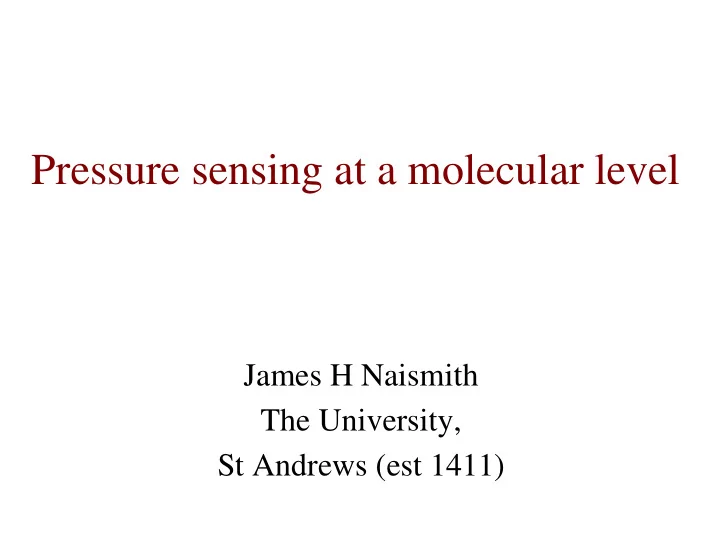

Pressure sensing at a molecular level James H Naismith The University, St Andrews (est 1411)
Acknowledgements • Wenjiang Wang, Changjiang Dong, Kostas Beis, Gregor Hageluken, Emma Brannigan, Christos Pliotas*, Richard Ward, Phedra Marius, Terry Smith, Jim Naismith & Olav Schiemann • Ian Booth, Michelle Edwards, Susan Black, Sam Miller, Wendy Bartlett, Akikio Rasmussen (Aberdeen) • Hagan Bayley, Mahendran (Oxford) • Friendly discussion Bass & Rees; Perozo BBSRC, Wellcome Trust, St Andrews
Mechanosensitive channels • Bacteria experience rapid changes in osmotic pressure • Without the release of ions from inside cytoplasm, they would explode – Transfer to water creates pressures of > 14 atm • Mechanosensitive channels open, allowing rapid efflux of ions and small solutes • Need tight seal normally • Relatively small free energy between states
A priori • Structures came from the Rees lab : – MscL 3.5 Å structure (G. Chang, et al, Science 282, 2220 (1998) ) new structure Liu et al., 2009, Nature, 461, 120-4 ) – MscS 3.95 Å, (R. Bass et al, Science 298, 1582 (2002) • Open to close transitions – Model: Sukharev et al., Nature 409, 720 (2000) – EPR: Perozo, Nature 418, 942 (2002) – FRET: Corry, Biophys 91, 1032 (2006); Martinac, B., • Lipids – Blount, P.; Perozo, E. and Lee, A .
Mechanosensitive channels Taken from Naismith & Booth, 2012
How does MscS feel pressure? Lyso-PC simulates pressure
a Periplasm N Closed book? Cytoplasm C d e Compact barrel with NATURE STRUCTURAL & MOLECULAR BIOLOGY VOLUME 14, 1141
3.1 Å D67R1 structure A& B& C&
PE lipids are bound to MscS 7 2 0 .4 0 3 .2 e 7 PG 32:1 PG 34:1 3 .0 e 7 PG 30:1 7 4 8 .5 6 PG PE 2 .5 e 7 6 9 2 .3 2 In ten sity, cp s Extracted PE 30:2 2 .0 e 7 6 5 6 .4 0 6 9 4 .3 2 7 4 6 .4 8 1 .5 e 7 PG 36:2 PE 32:3 6 0 0 .8 8 7 7 4 .5 6 6 8 2 .3 2 7 2 2 .0 8 PE 26:0 1 .0 e 7 7 3 4 .1 6 6 0 2 .0 0 7 1 8 .4 0 6 8 9 .2 8 7 6 6 .4 8 7 7 6 .0 0 6 7 0 .4 0 5 .0 e 6 6 4 2 .4 0 6 0 3 .9 2 6 8 4 .0 8 7 2 3 .6 8 8 1 2 .7 2 7 7 0 .4 08 0 4 .0 0 7 2 9 .6 0 6 9 1 .0 4 9 5 3 .3 6 8 5 8 .0 8 6 2 8 .4 0 8 0 8 .0 0 9 6 8 .7 2 6 6 1 .7 6 8 2 4 .3 2 8 9 7 .2 8 9 1 6 .8 8 7 0 5 .5 2 7 8 4 .2 4 7 5 8 .4 8 6 2 2 .0 8 9 7 0 .4 0 8 7 7 .7 6 9 9 5 .6 8 0 .0 6 0 0 6 5 0 7 0 0 7 5 0 8 0 0 8 5 0 9 0 0 9 5 0 1 0 0 0 m /z, D a 7 3 4 .1 6 1 .6 e 9 PG 33:1 1 .4 e 9 1 .2 e 9 In ten sity, cp s 1 .0 e 9 8 .0 e 8 PG 32:1 PG 34:1 PG 31:0 PE 35:1 6 .0 e 8 7 2 0 .1 6 7 4 8 .1 6 7 6 2 .2 4 PG 30:1 PG 36:2 7 2 2 .1 6 4 .0 e 8 7 7 4 .1 6 7 3 6 .1 6 PG 28:0 7 4 6 .1 6 6 9 4 .2 4 7 7 5 .1 2 2 .0 e 8 7 0 8 .2 4 7 5 0 .1 6 7 6 4 .0 8 6 9 2 .1 6 6 6 6 .1 6 7 1 8 .2 4 8 0 2 .1 6 8 4 6 .3 2 9 1 6 .3 2 9 4 2 .3 2 6 3 8 .3 2 8 2 4 .0 8 8 5 3 .8 4 8 8 8 .2 4 9 9 2 .3 2 0 .0 6 0 0 6 5 0 7 0 0 7 5 0 8 0 0 8 5 0 9 0 0 9 5 0 1 0 0 0 m /z, D a Figure&X2.&Lipidomics&analysis&of&purified&MscS&D67R1&and&expression&background&strain&
Molecular model of pressure reased$turgor$pressure,$membrane$stretches,$$ sensing lipids$move$to$bilayer$ Open$conformaUon$ • Our model based on differential lipidation; different but related to Schmidt & Mackinnon PNAS 2013. Looking again at Kv, shows it too has very different lipid interacting regions in the open from the closed structure
Recommend
More recommend